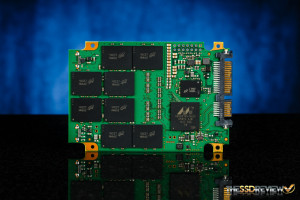A CLOSER LOOK INSIDE
After separating the two metal shells that protect the MX200, we get a closer look at the components within.


On the left we have the 1TB model and on the right the 500GB model. The overall layout is very similar between the two. They both have 8 NAND packages on the front, a Marvell controller, Micron DRAM cache, and power-loss circuit. If you even look at the PCB of the 1TB M600 SSD we reviewed last September, you can see it is the same as the 1TB MX200, NAND and DRAM included.


The back side is where we start to see more of a difference. The 1TB model has an additional 8 NAND packages and another DRAM chip, while the 500GB model remains bare save for a few SMDs.
Having a closer look at the power-loss circuit for each SSD, we can see a little more than double the capacitors on the 1TB model.
Powering each MX200 is the well-known and highly reliable 8 channel 88SS9189 Marvell SATA controller. This has been Crucial’s choice since the M550 was introduced and now spans three of their products. Both SSDs tested today also utilize the same NAND and DRAM.
The MX200 contains Micron’s NAND flash memory, as well as a single Micron cache memory chip on the front and another on the back of the 1TB model. By using the Micron FBGA Decoder, we can identify the NAND flash as having the product number MT29F512G08CKCCBH7-10:C. It is 16nm synchronous MLC NAND flash memory with each module being 32GB in capacity. Although the total RAW capacity of these SSDs are 500GB and 1TB, usable storage space is 465GB and 931GB respectively.
Furthermore, we can identify the DRAM memory as having the product number MT42L256M16D1GU-18 WT:A. The DRAM chips are 256MB of LPDDR2 that run at 533MHz.
 Finally, within the case there is a thermal pad that rests against the PCB to help dissipate heat.
Finally, within the case there is a thermal pad that rests against the PCB to help dissipate heat.
 The SSD Review The Worlds Dedicated SSD Education and Review Resource |
The SSD Review The Worlds Dedicated SSD Education and Review Resource | 
It is obvious that you do not always need the 7mm to 9.5mm spacer. When is a spacer typically necessary? I just replaced two 9.5mm drives with 7mm drives; neither 7mm drive came with a spacer and neither needed a spacer. Micron kind of says the spacer is included so you will have it if you need it.
Jim
Older notebooks require the spacer in order to secure th SSD properly.
Thank you!
The spacer is definitely needed with many laptops. Older Dells, for instance.
Thanks!
Jim
Mark and Les-
Do the older ones that need spacers not have screw mounts? My newer Acer netbook (screw mount) came with a 9.5mm but its maintenance guide said it would take either one. My older Acer notebook (screw mount) came with a 9.5mm but its maintenance guide specified 9.5mm; it predated the 7.5mm so I tried the 7mm and it worked fine. I wonder if the spacer is needed for things like external USB drive cases that do not actually have screws holding the drive.
Jim
My older toshiba was a screw-less 9.5mm. It actually used the bottom cover to hold in the drive. Without the spacer, the SSD would just flop up and down. Not good.
Thanks!
Hey Les, long time reader (love the site). Quick question-most of my reading is done to determine which SSDs can help us most in HD video capture & transfer (raw uncompressed). We typically use the Blackmagic Speed Test to determine where a SSD stands before buying. Which of the test that you guys typically run gives me the closest indication to the Blackmagic test? (i.e. which will let me know best how the SSD performs under the test of raw uncompressed data) Thanks 🙂
If you are looking for a benchmark, I would have to say AS SSD is the quick and easy way to test and it is free.
So if you were deciding between the M550 and the MX200 (in 500gb form), which would be the better choice? Assume prices are either exactly the same or not a factor in the decision.
I am with the MX200. Either way, don’t hesitate to follow our links; every little bit helps.
If 850EVO happens to be around the same price as those two, its worth checking that out too.
5 year warranty is great if things go south 🙂
Finally, Crucial has released a firmware update to address the problems with the MX100 drives. I haven’t been successful yet in applying the update, as is noted by many on their forum, but I thought it would be good to post the info here (since I decided to get two MX100’s as a result of the review on this site):
https://forum.crucial.com/t5/Crucial-SSDs/Feedback-Thread-Firmware-MU02-for-MX100/td-p/165974
Sean why don’t the MX200 recover in the PCMark 8 test????
Is this deferred GC or are we stuck with those low speeds????
Those are the speeds it produced going through the test. Due to the firmware it doesn’t seem that it is able to recover quick enough to perform better in the light workloads within the time frame. However, wasn’t developed to deal with constant writes such as are issued out in the PCMark 8 consistency test, thus it doesn’t do too well in it. Our run in PCMark Vantage shows that it does perform a lot better if it isn’t constantly strained. So real world you shouldn’t have much to worry about.
Nice review. Here is a comparison with Crucial M552! Which is the best ?
https://www.techwarn.com/crucial-mx200-vs-m550-review/
Nice Piece of information for the concerned people